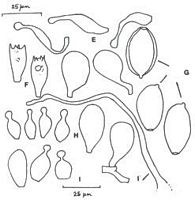|
 Conocybe pubescens Conocybe pubescens
SynonymsGalera pubescens
BiostatusPresent in region - Exotic
Images (click to enlarge)
Caption: E-l Taylor 1346, E. Pileipellis units; F. Basidia; G. Basidiospores; H. Cheilocystidia; 1. Caulocystidia; I'. Hair from caulo hymenium. |
Article: Watling, R.; Taylor, G.M. (1987). Observations on the Bolbitiaceae: 27. Preliminary account of the Bolbitiaceae of New Zealand. Bibliotheca Mycologica 117: 61 p. + 17 pl.
Description: No field data is available for the Waitakere Range collection but the microscopic characters agree with the north temperate agaric and are offered herein.
Basidiospores 15-16 x 8.5-9 µm. elliptic in face-view slightly flattened in side-view, thick-walled; germ-pore broad central. Basidia 24-26 x 11-13 µm, Cheilocystidia lecythiform, 16-20 x 8-10 µm with capitulum 3 µm broad. Pileipellis a palisadoderm of spheropedunculate cells ≥30 µm broad, intermixed with hair-like cells ≥75 µm long and ≥2 µm broad, and tibiiform cells 37 x 6 µm, some yellowish in alkaline solutions and with capitulum >6µm. Stipitipellis of cylindric parallel hyphae (7 µm broad) supporting mixture of hair-like cells with extremely broad, but neck poorly differentiated. Clamp-connection present.
Notes: One interesting feature of this collection is the blueing of some of the hair-like cells on the pileus in alkali solutions. Such a phenomenon has been found in neither European collections of this taxon nor indeed, as yet, in other species of the genus Conocybe. The significance of this unusual reaction must be monitored. Bell (1983) records C. pubescens from dung in New Zealand but there has apparently been some misinterpretation of the data. The basidiospores of C. pubescens in Bell (as 'sensu Richardson & Watling' ) is given as 8-9 x 5-6 µm when Richardson & Watling (1968) give 'Basidiospores larger over 15 µm long x up to 10 µm broad'; see Watling, 1982. With no further details the species figured by Bell (1983) can neither be determined, nor placed in either sect. Pilosellae or sect. Farinosae. We can only think that the couplet in the key has been switched giving C. pubescens the small spore-size, whilst C. rickenii was given spores 17-20 x 10-13 µm.
|